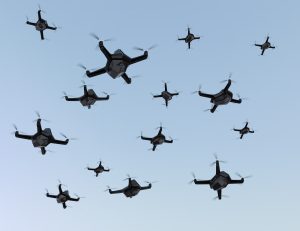The COP26 climate conference in Glasgow, which concluded last week, saw the expected skirmishes between governments, industries, and campaigning groups around the crucial questions of how to mitigate the worst impacts of a rapidly-warming world. The debates have focused primarily on carbon emissions by sector and questions of fairness between the developed and developing world. But the backdrop is the increasingly sharp strategic competition defining world politics.
That competition, as with its historical antecedents, is taking on an increasingly militarized character. Militaries are themselves a substantial contributor of carbon emissions, but attempting to bring those emissions down may put two overarching harm reduction goals at odds with each other.
The most straightforward way to reduce military carbon footprints would, of course, be a sharp, across-the-board reduction in military expenditure and ambition — if not full disarmament than at least a substantial reversal of the current upward trajectory of military expenditures. But despite the talk of collaboration in Glasgow, the world isn’t becoming more harmonious, and few if any leaders are willing to take the plunge on unilateral disarmament. Realistically, the question is whether militaries can be made more carbon-neutral, not whether they can be unmade.
In this month’s edition of the magazine, I wrote about the difficulties inherent in doing exactly that. The biggest obstacles, as I observed, would be greening the kinds of capabilities necessary for expeditionary militaries: strategic airlift, long-range strike, and blue-water naval assets.
Most militaries are not expeditionary and even those that are have numerous missions that could be accomplished by other means. Territorial defense, surveillance, anti-submarine warfare, and urban operations are all likely to be revolutionized by the advent of small, networked sensors or robots. Those types of assets are much easier to run on renewable energy than bombers, tanks, or frigates. Indeed, for some missions — long-duration naval patrol, for example — something like a solar- or wave-powered drone ship has actual tactical advantages over an internal combustion-powered one, not least endurance and quiet operation.
The model here would look something like this: Instead of using large carbon-intensive assets like warships or maritime aircraft to patrol sovereign territory, a network of smaller autonomous units could monitor it, identifying and investigating violations and even potentially carrying weapons to attack hostile invaders. A network of smaller robots could provide a more flexible response and potentially be more survivable, given that it would take a far greater expenditure of effort to find and strike dozens of small targets than a handful of large ones. Plus, small robots do allow some space for de-escalation, given that their destruction does not have the same political or strategic impact as the killing of human soldiers.
Of course, until such systems prove that they can survive the rigors of the real world, and until tactics which leverage their unique qualities are developed, refined, and successfully demonstrated, this may all be a moot point. Militaries — and the civilian policymakers they report to — are generally not incentivized to pursue unproven, risky transformations, especially at the cost of proven systems and approaches. That, of course, has not stopped rapid developments in the field; it seems likely that some version of this transformation is coming sooner or later, even if environmental issues are not the primary driver.
But adopting these technologies also sets up a conflict between different regulatory goals. A military reliant on networks of renewable energy-powered nodes will also, inherently, be more reliant on autonomy. That creates a much more complex challenge for attempts to limit the spread of autonomy in military decision-making.
Why is this the case? There are a few reasons. First, although it gets far less attention than more visible aspects of warfare, the modern battlefield is awash with electronic jamming, spoofing, hacking, and countermeasures. In the event of a conflict between technologically sophisticated militaries, there is no guarantee that crucial sensor data or commands could be transmitted back and forth reliably. Under those circumstances, a robot without a degree of autonomy is virtually useless.
Second, and relatedly, autonomy allows greater economies of scale. Large, traditional UAVs like the MQ-9 Reaper are operated by teams of humans, reflecting the fact that they are scaled (and tasked) comparably to piloted aircraft. Part of the comparative advantage of a swarm of smaller drones is their ability to cover a greater area without requiring an equally large number of human operators. Enabling the individual units of a swarm to operate under the command of a single human necessarily entails imbuing them with a degree of independence and as that economy of scale grows, so too will the amount of autonomy. The alternative is to revert to direct human control, which would require carbon-intensive vehicles.
In other words, a greener military is almost certainly going to be one that pushes the boundaries of autonomy farther — with, accordingly, greater risks to the established rules of human control over violence, such as they are. In the absence of a historically unprecedented level of mutual disarmament, navigating this moral complexity will be the next task for policymakers to tackle.

































